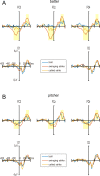Error-related negativity predicts failure in competitive dual-player video games
- PMID: 30818382
- PMCID: PMC6394958
- DOI: 10.1371/journal.pone.0212483
Error-related negativity predicts failure in competitive dual-player video games
Abstract
Along with improvement in electroencephalogram (EEG)-measurement technology, limitations on the situations in which data can be recorded are gradually being overcome. EEG measurement in real environments has become increasingly important as a means to monitor brain activity in our daily lives, such as while playing consumer games in the living room. The present study measured brain EEG activity while two players engaged in a competitive consumer baseball game in conditions that closely resembled daily life. The recorded brain activity was thus likely related to natural mental reactions and cognitive function that occur in similar daily life activities. To measure the EEG from participants who freely moved while playing the game, we developed EEG devices that incorporated a wireless time synchronization system using Global Positioning Satellite (GPS) signals. These devices stamped the time obtained from the GPS signals onto each data sample, which was then used to synchronize the data that were recorded by different devices. When the batter in the game swung and missed, the error-related negativity component of the event-related EEG potential was strongly evoked in frontal electrodes of the participant controlling the batter. Furthermore, the error-related negativity was modulated according to who was winning and by how much. Thus, here we have demonstrated "real-world" brain activity using a competitive consumer game, which increases intrinsic participant motivation.
Conflict of interest statement
The authors have declared that no competing interests exist.
Figures







Similar articles
-
Cool, callous and in control: superior inhibitory control in frequent players of video games with violent content.Soc Cogn Affect Neurosci. 2017 Dec 1;12(12):1869-1880. doi: 10.1093/scan/nsx115. Soc Cogn Affect Neurosci. 2017. PMID: 29040750 Free PMC article.
-
EEG in game user analysis: A framework for expertise classification during gameplay.PLoS One. 2021 Jun 18;16(6):e0246913. doi: 10.1371/journal.pone.0246913. eCollection 2021. PLoS One. 2021. PMID: 34143774 Free PMC article.
-
A negative association between video game experience and proactive cognitive control.Psychophysiology. 2010 Jan 1;47(1):34-42. doi: 10.1111/j.1469-8986.2009.00925.x. Epub 2009 Oct 8. Psychophysiology. 2010. PMID: 19818048
-
Recent Advances in General Game Playing.ScientificWorldJournal. 2015;2015:986262. doi: 10.1155/2015/986262. Epub 2015 Aug 24. ScientificWorldJournal. 2015. PMID: 26380375 Free PMC article. Review.
-
The use of technology and sampling frequency to measure variables of tactical positioning in team sports: a systematic review.Res Sports Med. 2020 Apr-Jun;28(2):279-292. doi: 10.1080/15438627.2019.1660879. Epub 2019 Sep 13. Res Sports Med. 2020. PMID: 31516016
Cited by
-
Measuring Task-Related Brain Activity With Event-Related Potentials in Dynamic Task Scenario With Immersive Virtual Reality Environment.Front Behav Neurosci. 2022 Feb 2;16:779926. doi: 10.3389/fnbeh.2022.779926. eCollection 2022. Front Behav Neurosci. 2022. PMID: 35185487 Free PMC article.
-
Green communication for cognitive radio networks based on game and utility-pricing theories.PLoS One. 2020 Aug 25;15(8):e0235953. doi: 10.1371/journal.pone.0235953. eCollection 2020. PLoS One. 2020. PMID: 32841253 Free PMC article.
-
Error-Related Cognitive Control and Behavioral Adaptation Mechanisms in the Context of Motor Functioning and Anxiety.Front Hum Neurosci. 2021 Feb 5;15:615616. doi: 10.3389/fnhum.2021.615616. eCollection 2021. Front Hum Neurosci. 2021. PMID: 33613211 Free PMC article.
-
Popularity of Video Games and Collective Memory.Entropy (Basel). 2022 Jun 23;24(7):860. doi: 10.3390/e24070860. Entropy (Basel). 2022. PMID: 35885084 Free PMC article.
-
Errors and Action Monitoring: Errare Humanum Est Sed Corrigere Possibile.Front Hum Neurosci. 2020 Jan 9;13:453. doi: 10.3389/fnhum.2019.00453. eCollection 2019. Front Hum Neurosci. 2020. PMID: 31998101 Free PMC article. Review.
References
-
- Ryan MR, Rigby CS, Przybylski A (2006) The motivational pull of video games: a self-determination theory approach. Motiv Emot 30: 344–360.
-
- Przybylski AK, Rigby CS, Ryan RM (2010) A motivational model of video game engagement. Rev Gen Psychol 14: 154–166.
Publication types
MeSH terms
LinkOut - more resources
Full Text Sources

